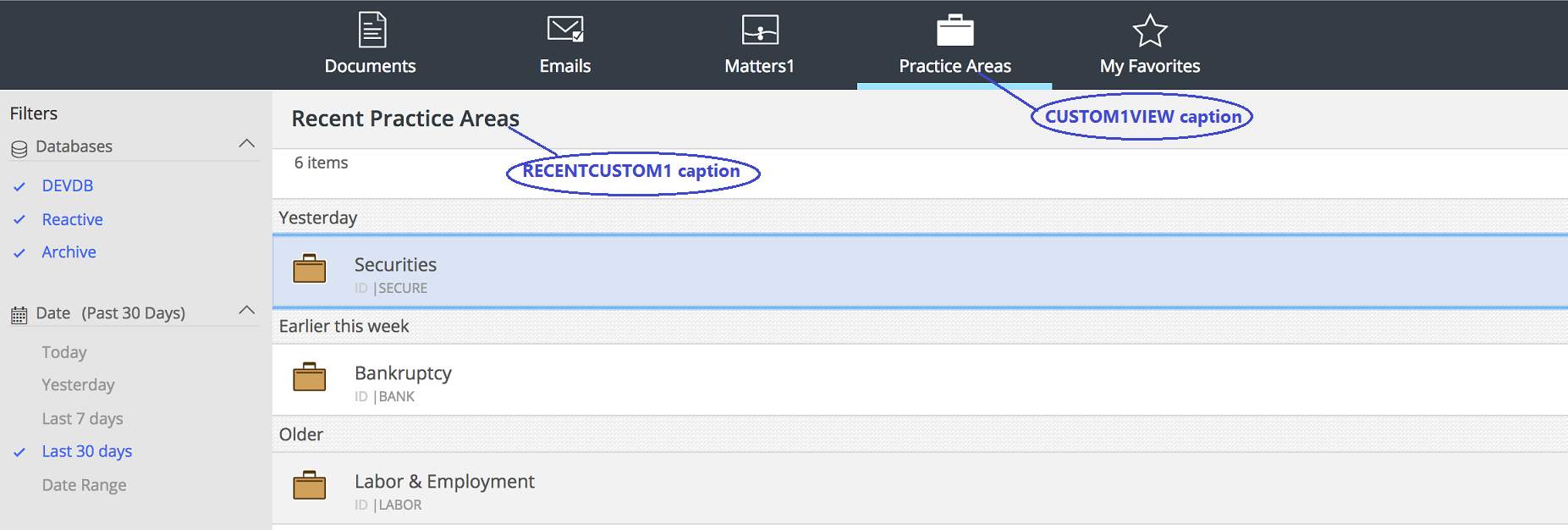Settings
Based on your environment, access the Web Client > Settings tab by navigating to:
Settings > Web Client > Settings
or
Work Clients > Web Client > Settings
The Settings page contains the following three tabs:
General: configure general iManage Work 10 Web settings.
Feature: customize different feature options for the iManage Work 10 Web.
Access: define which groups can sign in to iManage Work 10 Web .
Configure general settings
To configure general settings for iManage Work 10 Web, navigate to the General tab.
Set the default language for iManage Work applications using the Default Language option.
Hide specific languages by following these steps.
Customize your organization logo for iManage Work applications using the Customize Logo option.
Figure: General settings tab
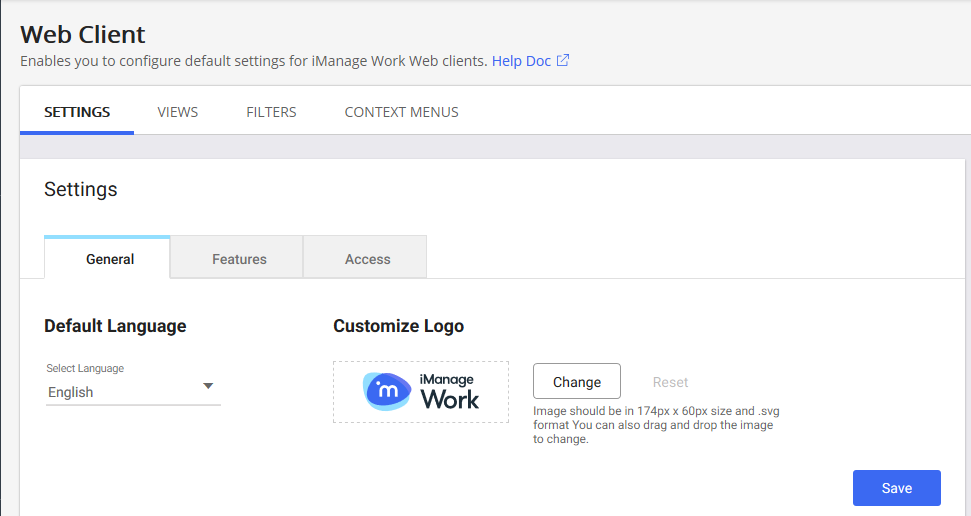
Setting the default language
Select a language from the Select Language drop-down list, and then select Save. When users launch iManage Work application, the application appears in the selected language.
Hiding a specific language from browsers
Create a new file: C:\Program Files\Autonomy\WorkSite\WorkWebServer\settings.py
Add the following contents to the file, excluding any languages you do not want:
# -*- coding: UTF-8 -*-# Supported Languages IM_LOCALES = [ {'id': 'en-US', 'name': 'English'}, {'id': 'fr-FR', 'name': 'Français'}, {'id': 'es-ES', 'name': 'Español'}, {'id': 'de-DE', 'name': 'Deutsch'}, {'id': 'pt-BR', 'name': 'Português (Brasil)'}, {'id': 'ja-JP', 'name': '日本語'}, {'id': 'zh-CN', 'name': '中文简体'}]
Customizing the Logo
This section describes how to customize or change the logo displayed in iManage Work. The logo appears in the iManage Work at the following places:
Page headers (desktop view)
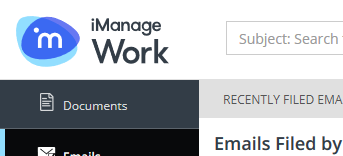
Left sidebar (mobile view)
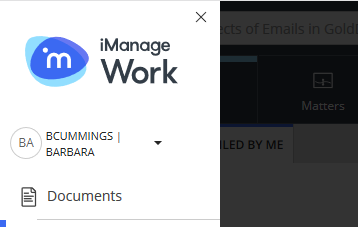
Custom Logo File Requirements
The image must be in SVG format as it appears crisp in high density displays. You cannot upload an image in any other format such as JPG, PNG, GIF and so on.
The image size should be 174px x 60px. If the size of your image does not match, it will be scaled to 174px x 60 px automatically. However, the logo may appear distorted.
The SVG files exported from tools such as Adobe Illustrator or Sketch work properly without any additional effort. However, if the logo does not appear in the UI, open the image file in a text editor to view its XML format. Verify that the <svg> element has both xmlns and xmlns:xlink attributes are set. If these attributes are missing, the logo may not render.
For example, <svg xmlns="http://www.w3.org/2000/svg" xmlns:xlink="http://www.w3.org/1999/xlink" … > …. </svg>
Steps to Customize Logo
In the Customize Logo section of the General tab, select Change.
Figure: Settings
The file upload dialog opens.
Locate and select the new logo. Select Open.
Alternatively, you can drag and drop the new logo into the Customize Logo area in your browser.
Select Save to apply the new logo.
Select Reset to restore the default iManage Work logo.
Configure features
To configure Work 10 Web features, navigate to the Features
tab.
Figure: Features
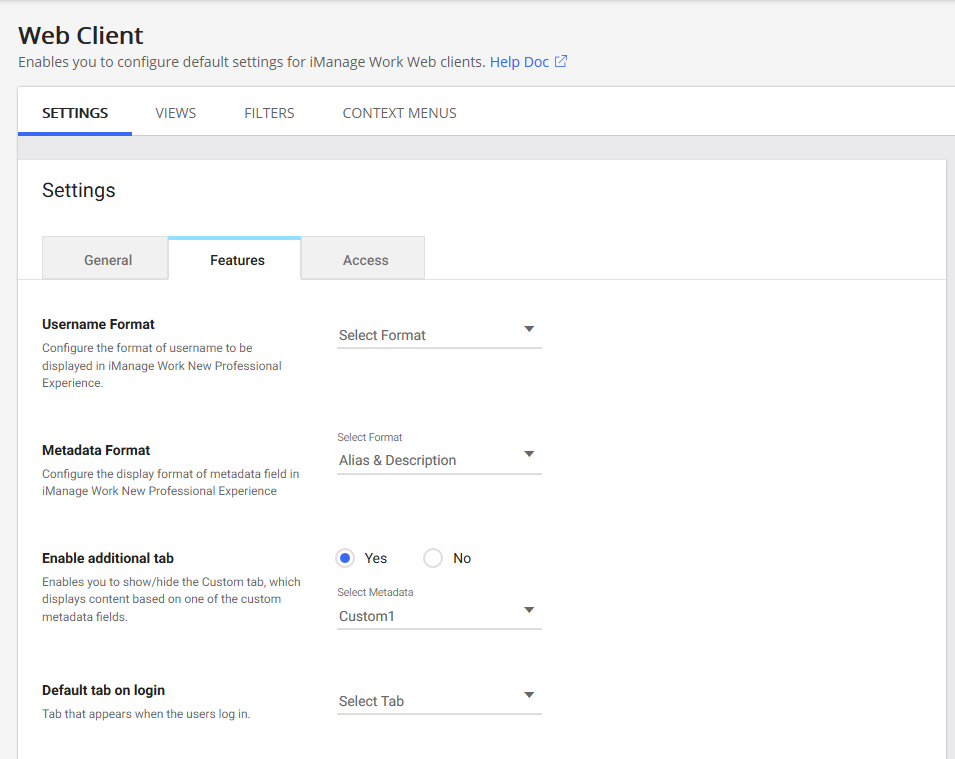
Customize any of the following Work 10 features, then click Save.
Table: Feature options
|
Option |
Steps/description |
|
Username Format |
Select the format of username to be displayed in iManage Work. |
|
Metadata Format |
Select Alias & Description or Description Only or both as the format for custom metadata fields to be displayed in iManage Work. |
|
Enable additional tab |
Enables and configures an
additional tab on the iManage Work home page. By default, this setting is disabled. When enabled, the additional tab displays a list of clients based on the user's recent activity. It is populated using the Custom1 metadata field. You can also chose a different metadata field between Custom1-12 and Custom29-30. This setting is enforced over the legacy registry setting "Custom View Metadata Field". Select Yes to add an additional tab, then select the metadata from the drop-down list. Optionally, select METADATA > Captions, and update the captions for CUSTOM1VIEW, and RECENTCUSTOM1 to reflect appropriate labels in iManage Work for the additional tab, and recent items. For example, if Practice Areas is added as an additional tab, then update the captions to reflect labels in iManage Work as Practice Areas, and Recent Practice Areas. Figure: iManage Work Home Page
|
|
Default tab on Login |
Select which tab is loaded when users sign in to iManage Work. If not set, the Documents tab is displayed by default. Users can overwrite this preference and set their Web Default Tab in their User Settings.
Figure: Default tab displayed on login
|
|
Lookup field dropdown limit |
Configures the number of suggestions shown in the dropdown of lookup fields. The default is 150 suggestions. |
|
Enable Google Tag Manager tracking |
Select Yes to collect anonymous data through Google Tag Manager to track application usage information. No private data, such as user names or metadata, is sent to iManage.
iManage Work 10 previously used Google Analytics for the same purpose. Google Tag Manager provides increased flexibility in performing measurements to understand how features are being used. Analytics using Google Tag Manager is disabled by default. You must explicitly accept the license agreement. Until this is done, tracking will be disabled, even if the previous license agreement has been accepted. |
|
Enable Work 10 Desktop for Windows Auto Updates App Banner |
Select the Windows check box if you want your end-users to see the following Enable Work 10 Desktop for Windows Auto Updates App Banner in the iManage Work application (Work Web client) By default, this check box is not selected. Only those end-users who do not have iManage Work Desktop for Windows will see this banner.
Figure: iManage Auto Updates Banner |
|
Internet Explorer Warning Message |
The first time a user signs in to Work 10 using Internet Explorer, display a banner recommending use of a fully supported browser.
Figure: Internet Explorer message See the List of limitations applicable to Microsoft browsers for more information. |
|
Enable Search Language Selection |
Configures whether the language search selection option is visible for simple and advanced searches in iManage Work.
Figure: Language search selection option (when enabled)
|
|
Title-click operation for files |
Configures the default action when a user clicks the title of a document or email. This option applies to iManage Work in a Desktop browser, iManage Work panel in Outlook, and Work Desktop for Mac.
The Edit/Open option should only be used if all your users have iManage Work Desktop for Windows or iManage Work for Mac installed. If this software is not available on users' machines, the the following message will be displayed: You need to install iManage Office Integration to edit this document.
The Open in Protected Mode option is not currently supported for iManage Work Desktop for Mac. When this option is selected, the title-click action defaults to the Edit/Open functionality. |
Configure access settings
To d
efine which groups can sign in to iManage Work 10 Web,
navigate to the Access
tab.
The users who are not in this list can still access iManage Work for Office, iManage Work 10 for Mobility, and iManage Work classic clients.
This feature is useful for firms who decide to provide the mobile access of iManage Work client application only to specific users, and control the data that is left on the devices. For example, mobile access is provided only to partners and attorneys, while the document support staff and secretaries are restricted.
Figure: Access
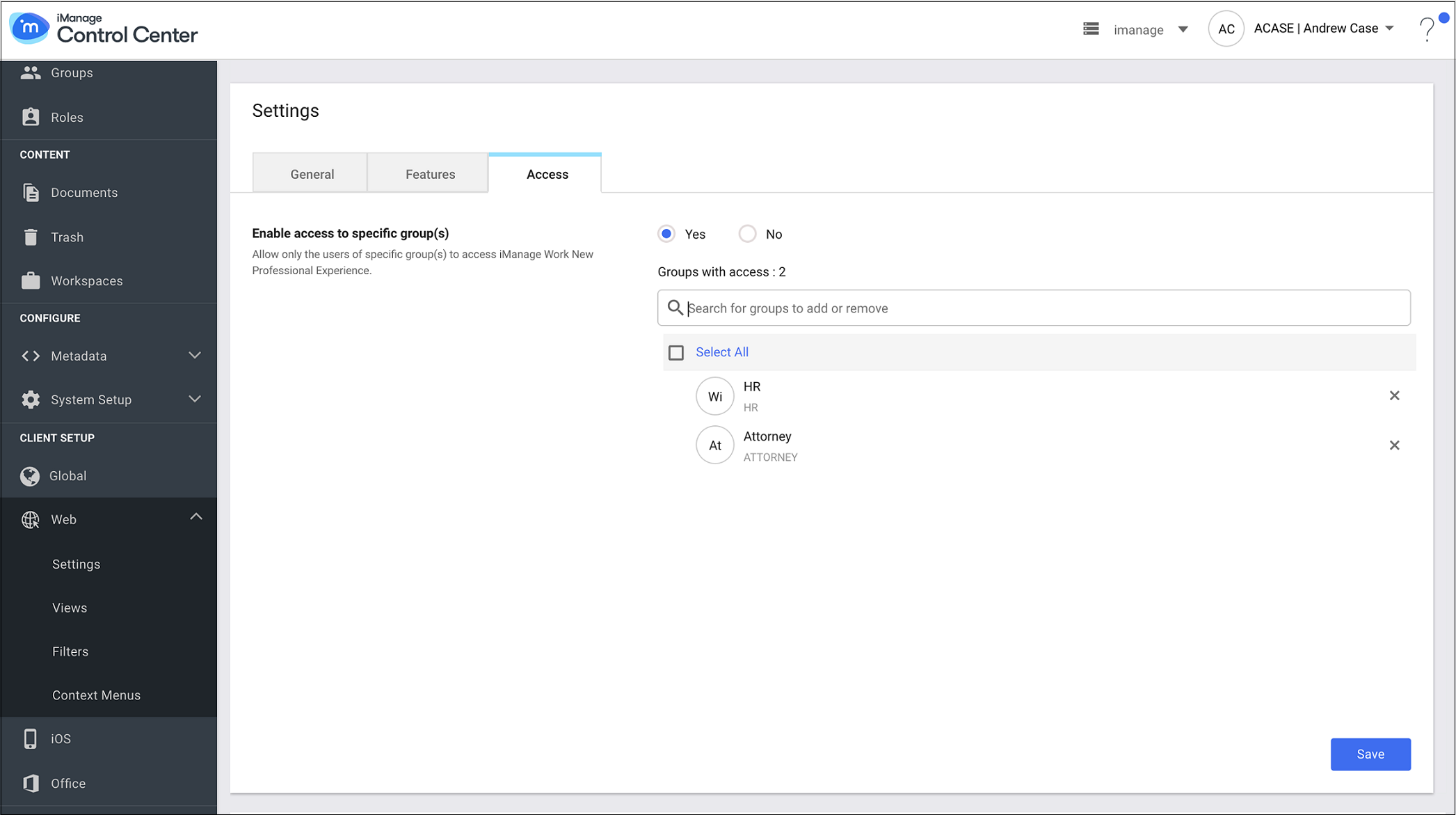
Select Yes to define which groups are allowed access to iManage Work. The field to search for groups appears.
Enter a name of the group to be added, and select Add to provide access to the group.
Click X to remove the group that has already been added.
Select No to prevent access to iManage Work for any users.
Select Save.
